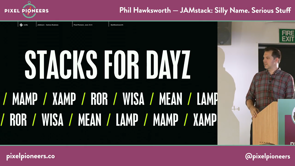


Do we really need this JAMstack thing? And what even is it?
In this session, we’ll demystify the buzzwordy term, and explore how the approach to simplifying the technology stack can lead to shorter development times, with better performance and greater security.
We’ll see how the JAMstack is placing more power, more confidence, and more capabilities in the hands of designers, authors and front-end developers.
And we’ll show how serverless functions can augment this stack to let us rapidly build interfaces and APIs to power sites that we’d be brave enough to share with the world.